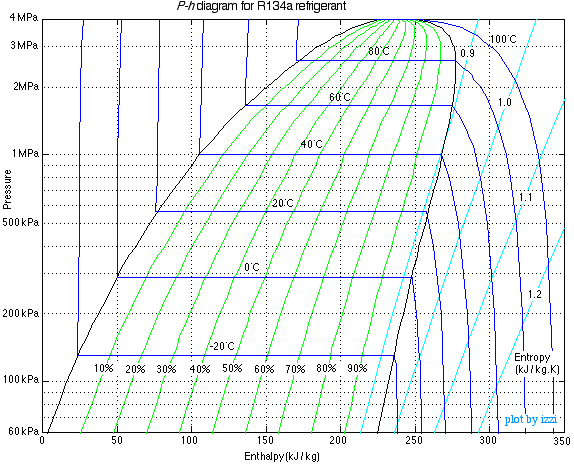Problem 4.13 - The BSU Geothermal Heat Pump System (Summertime)
Introduction and Description
With the global quest for energy efficiency, there is renewed interest in geothermal heat pumps which have been in limited use for more than 70 years. Essentially this technology relies on the fact that a few meters below the surface of the earth the temperature remains relatively constant throughout the year, warmer than the air above it during winter, and cooler during summer. According to the Spring 2009 newsletter from David White, in Southeast Ohio this temperature is around 55°F (13°C). This means that we can design a heat pump which can combine hot water and space heating in winter in which the earth is used as a heat source (rather than the outside air) at a considerable increase in coefficient of performance COP. Similarly, with suitable valving, we can use the same system in summer for hot water heating and air conditioning in which the earth is used as a heat sink, rather than the outside air. This is achieved by using a Ground Loop in order to enable heat transfer with the earth, as described in the Popular Mechanics website: The Guide to Home Geothermal Energy, and of course the ubiquitous Wikipedia. Another relevant website is that by Mortgage Calculator titled Geothermal Resources for Homeowners (Thanks to Aaron March of Jericho, VT, for making us aware of this interesting website - Nov 21, 2011.)
![]() Problem
4.13 - On Friday Sept 24, 2010 professor John
Vann from Ball
State University in Indiana came to Ohio
University to speak about BSU's switch from coal powered heat to
geothermal heat. This impressive project will take 5 years to
complete, and is one of the nation's largest closed geothermal energy
systems. The talk did not include many technical details, however he
did describe the overall
BSU system, which includes 4100 boreholes
to extract or reject heat to the earth, and then transfer that heat
through two energy stations to a network of hot water and chilled
water loops flowing through the entire campus to provide hot water
(at around 150°F) and space heating or cooling as required. (Update:
The system was completed in 2012).
Problem
4.13 - On Friday Sept 24, 2010 professor John
Vann from Ball
State University in Indiana came to Ohio
University to speak about BSU's switch from coal powered heat to
geothermal heat. This impressive project will take 5 years to
complete, and is one of the nation's largest closed geothermal energy
systems. The talk did not include many technical details, however he
did describe the overall
BSU system, which includes 4100 boreholes
to extract or reject heat to the earth, and then transfer that heat
through two energy stations to a network of hot water and chilled
water loops flowing through the entire campus to provide hot water
(at around 150°F) and space heating or cooling as required. (Update:
The system was completed in 2012).
We were intrigued by the concept and would like to evaluate the thermodynamic feasibility and performance of a geothermal heat pump system. The following system diagram represents a possible system for summertime usage, in order to provide hot water at 65°C, and space cooling using chilled water at around 13°C. Note that this system was devised by us for purposes of this concept feasibility check only, and no data about the system was obtained from BSU. We used the Refrigerant R134a, since this was the only refrigerant for which we had tables available. In fact we had to add new data to our tables, since with a limit of 1.6 MPa we could not reach the required temperature of 65°C. Note that the mass flow and actual power required is not specified, thus this model will represent a system suitable for any size. All energy results will be in units of kJ/kg.
Using the conditions shown on the diagram do the following
a) On the P-h diagram provided below carefully plot the five processes of the heat pump together with the following constant temperature lines: 65°C (hot water), 13°C (ground loop).
b) Using the R134a property tables determine the enthalpies at all five stations and verify and indicate their values on the P-h diagram.
c) Determine the energy absorbed by the hot water flow [150 kJ/kg] and that extracted from the chilled water [174.5 kJ/kg].
d) Determine the energy required to drive the compressor [43.8 kJ/kg]
e) Determine the Coefficient of Performance of the hot water heating system (COPHW) (defined as the heat absorbed by the hot water divided by the work done on the compressor) [COPHW = 3.4]
f) Determine the Coefficient of Performance of the chilled water system (COPR) (defined as the heat absorbed by the chilled water divided by the work done on the compressor).[COPR = 4.0]
g) Determine the change in performance of the system assuming that no geothermal water loop is used, and plot the changes in the processes on the P-h diagram. Discuss the advantages of the geothermal heat pump system for summertime usage.

______________________________________________________________________________________